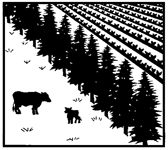U.S. Department of Agriculture: Forest Service -- National Agroforestry Center
Date of this Version
February 2005
Abstract
Trees and livestock account for much of the income production on lands throughout the southern United States. Today many landowners are combining these two operations into one system called silvopasture, where both timber and livestock are produced on the same field.
While economic gain is most often the primary goal of a silvopasture system, wildlife habitat enhancement is commonly seen as an added benefit. This Agroforestry Note discusses the habitat requirements of Eastern wild turkey with respect to management considerations for the production of timber and livestock forage within silvopasture systems.
Silvopasture systems typically are laid out by either planting widely spaced rows of trees (usually pines) onto an open pasture or by heavy thinning of a forest to allow sufficient light to reach the ground so that a livestock forage system can be established. See Agroforestry Notes 18 and 22. Minor modification can be made to greatly improve the value of a silvopasture system for wild turkey, while still retaining most of the timber and forage production potential.


Comments
Published by National Agroforestry Center, USDA Forest Service, Rocky Mountain Station, USDA Natural Resources Conservation Service, East Campus – UNL, Lincoln, Nebraska 68583-0822.